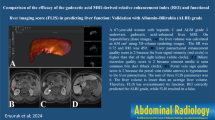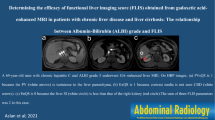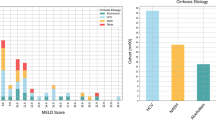Abstract
Purpose
The purpose of this study was to reveal the usefulness of machine learning classifier and feature selection algorithms for prediction of insufficient hepatic enhancement in the HBP.
Methods
We retrospectively assessed 214 patients with chronic liver disease or liver cirrhosis who underwent MRI enhanced with Gd-EOB-DTPA. Various liver function tests, Child–Pugh score (CPS) and Model for End-stage Liver Disease Sodium (MELD-Na) score were collected as candidate predictors for insufficient hepatic enhancement. Insufficient hepatic enhancement was assessed using liver-to-portal vein signal intensity ratio and 5-level visual grading. The clinico-laboratory findings were compared using Student’s t-test and Mann–Whitney U test. Relationships between the laboratory tests and insufficient hepatic enhancement were assessed using Pearson’s and Spearman’s rank correlation coefficient. Feature importance was assessed by Random UnderSampling boosting algorithms. The predictive models were constructed using decision tree(DT), k-nearest neighbor(KNN), random forest(RF), and support-vector machine(SVM) classifier algorithms. The performances of the prediction models were analyzed by calculating the area under the receiver operating characteristic curve(AUC).
Results
Among four machine learning classifier algorithms using various feature combinations, SVM using total bilirubin(TB) and albumin(Alb) showed excellent predictive ability for insufficient hepatic enhancement(AUC = 0.93, [95% CI: 0.93–0.94]) and higher AUC value than conventional logistic regression(LR) model (AUC = 0.92, [95% CI; 0.92–0.93], predictive models using the MELD-Na (AUC = 0.90 [95% CI: 0.89–0.91]) and CPS (AUC = 0.89 [95% CI: 0.88–0.90]).
Conclusion
Machine learning-based classifier (i.e. SVM) and feature selection algorithms can be used to predict insufficient hepatic enhancement in the HBP before performing MRI.
Graphic abstract






Similar content being viewed by others
Data availability
All authors checked that all data and materials support published claims and comply with field standards.
Code availability
Not applicable.
Abbreviations
- Gd-EOB-DTPA:
-
Gadolinium ethoxybenzyl diethylenetriamine pentaacetic acid
- HBP:
-
Hepatobiliary phase
- OATPs:
-
Organic anion-transporting polypeptides
- MRP:
-
Multidrug resistance-associated protein
- MRI:
-
Magnetic resonance imaging
- CPS:
-
Child–Pugh score
- MELD:
-
Model for End-stage Liver Disease
- LPR:
-
Liver-to-portal vein signal intensity ratio
- LPVC:
-
Liver-to-portal vein contrast
- RUSboosting:
-
Random UnderSampling boosting
- DT:
-
Decision trees
- KNN:
-
K-nearest neighbor
- RF:
-
Random forest
- SVM:
-
Support-vector machine
References
American College of Radiology: Liver Imaging Reporting and Data System version 2018. https://www.acr.org/Clinical-Resources/Reporting-and-Data-Systems/LI-RADS Accessed 7 June 2019.
Zizka J, Klzo L, Ferda J, Mrklovský M, Bukac J. (2007) Dynamic and delayed contrast enhancement in upper abdominal MRI studies: comparison of gadoxetic acid and gadobutrol. Eur J Radiol 62:186-191. https://doi.org/10.1016/j.ejrad.2007.02.035
Akai H, Matsuda I, Kiryu S, Tajima T, Takao H, Watanabe Y, et al. (2012) Fate of hypointense lesions on Gd-EOB-DTPA-enhanced magnetic resonance imaging. Eur J Radiol 81:2973-2977. https://doi.org/10.1016/j.ejrad.2012.01.007
Tsuboyama T, Onishi H, Kim T, Akita H, Hori M, Tatsumi M, et al. (2010) Hepatocellular carcinoma: hepatocyte-selective enhancement at gadoxetic acid-enhanced MR imaging--correlation with expression of sinusoidal and canalicular transporters and bile accumulation. Radiology 255:824-833. https://doi.org/10.1148/radiol.10091557
Kitao A, Zen Y, Matsui O, Gabata T, Kobayashi S, Koda W, et al. (2010) Hepatocellular carcinoma: signal intensity at gadoxetic acid-enhanced MR Imaging--correlation with molecular transporters and histopathologic features. Radiology 256:817-826. https://doi.org/10.1148/radiol.10092214
Hamm B, Staks T, Mühler A, Bollow M, Taupitz M, Frenzel T, et al. (1995) Phase I clinical evaluation of Gd-EOB-DTPA as a hepatobiliary MR contrast agent: safety, pharmacokinetics, and MR imaging. Radiology 195:785-792. https://doi.org/10.1148/radiology.195.3.7754011
Verloh N, Haimerl M, Rennert J, Müller-Wille R, Nießen C, Kirchner G, et al. (2013) Impact of liver cirrhosis on liver enhancement at Gd-EOB-DTPA enhanced MRI at 3 Tesla. Eur J Radiol 82:1710-1715. https://doi.org/10.1016/j.ejrad.2013.05.033
Tajima T, Takao H, Akai H, Kiryu S, Imamura H, Watanabe Y, et al. (2010) Relationship between liver function and liver signal intensity in hepatobiliary phase of gadolinium ethoxybenzyl diethylenetriamine pentaacetic acid-enhanced magnetic resonance imaging. J Comput Assist Tomogr 34:362-366. https://doi.org/10.1097/RCT.0b013e3181cd3304
Motosugi U, Ichikawa T, Sou H, Sano K, Tominaga L, Kitamura T, et al. (2009) Liver parenchymal enhancement of hepatocyte-phase images in Gd-EOB-DTPA-enhanced MR imaging: which biological markers of the liver function affect the enhancement? J Magn Reson Imaging 30:1042-1046. https://doi.org/10.1002/jmri.21956
Kim AY, Kim YK, Lee MW, Park MJ, Hwang J, Lee MH, et al. (2012) Detection of hepatocellular carcinoma in gadoxetic acid-enhanced MRI and diffusion-weighted MRI with respect to the severity of liver cirrhosis. Acta Radiol 53:830-838. https://doi.org/10.1258/ar.2012.120099
Cui E, Long W, Luo L, Hu M, Huang L, Chen X. (2017) Development and validation of a predictor of insufficient enhancement during the hepatobiliary phase of Gd-EOB-DTPA-enhanced magnetic resonance imaging. Acta Radiol 58:1174-1181. https://doi.org/10.1177/0284185116687170
Yang M, Zhang Y, Zhao W, Cheng W, Wang H, Guo S. (2020) Evaluation of liver function using liver parenchyma, spleen and portal vein signal intensities during the hepatobiliary phase in Gd-EOB-D TPA-enhanced MRI. BMC Medical Imaging 20:119. https://doi.org/10.1186/s12880-020-00519-7
Tamada T, Ito K, Yamamoto A, Yasokawa K, Higaki A, Kanki A, et al. (2013) Simple Method for evaluating the degree of liver parenchymal enhancement in the hepatobiliary phase of gadoxetic acid-enhanced magnetic resonance imaging. J Magn Reson Imaging 37:1115-1121. https://doi.org/10.1002/jmri.23912
Kamath PS, Wiesner RH, Malinchoc M, Kremers W, Therneau TM, Kosberg CL, et al. (2001) A model to predict survival in patients with end-stage liver disease. Hepatology 33:464-470. https://doi.org/10.1053/jhep.2001.22172
Kim WR, Biggins SW, Kremers WK, Wiesner RH, Kamath PS, Benson JT, et al. (2008) Hyponatremia and mortality among patients on the liver-transplant waiting list. N Engl J Med 359:1018-1026. https://doi.org/10.1056/NEJMoa0801209
Seiffert C, Khoshgoftaar TM, Hulse JV, Napolitano A. (2010) RUSBoost: A Hybrid Approach to Alleviating Class Imbalance. IEEE Transactions on Systems, Man, and Cybernetics - Part A: Systems and Humans 40:185-197. https://doi.org/10.1109/TSMCA.2009.2029559
Géron A. (2019) Hands-on Machine Learning with Scikit-Learn, Keras, and TensorFlow: Concepts, Tools, and Techniques to Build Intelligent Systems. O'Reilly Media, Incorporated,
Murphy KP. (2012) Machine Learning: A Probabilistic Perspective. The MIT Press,
Landis JR, Koch GG. (1977) The measurement of observer agreement for categorical data. Biometrics 33:159-174.
DeLong ER, DeLong DM, Clarke-Pearson DL. (1988) Comparing the areas under two or more correlated receiver operating characteristic curves: a nonparametric approach. Biometrics 44:837-845.
Kim SH, Jeong WK, Kim Y, Kim MY, Kim J, Pyo JY, et al. (2013) Hepatocellular carcinoma composed of two different histologic types: imaging features on gadoxetic acid-enhanced liver MRI. Clin Mol Hepatol 19:92-96. https://doi.org/10.3350/cmh.2013.19.1.92
Pastor CM, Planchamp C, Pochon S, Lorusso V, Montet X, Mayer J, et al. (2003) Kinetics of gadobenate dimeglumine in isolated perfused rat liver: MR imaging evaluation. Radiology 229:119-125. https://doi.org/10.1148/radiol.2291020726
Verloh N, Haimerl M, Zeman F, Schlabeck M, Barreiros A, Loss M, et al. (2014) Assessing liver function by liver enhancement during the hepatobiliary phase with Gd-EOB-DTPA-enhanced MRI at 3 Tesla. Eur Radiol 24:1013-1019. https://doi.org/10.1007/s00330-014-3108-y
Mori Y, Motosugi U, Shimizu T, Ichikawa S, Kromrey ML, Onishi H. (2020) Predicting Patients With Insufficient Liver Enhancement in the Hepatobiliary Phase Before the Injection of Gadoxetic Acid: A Practical Approach Using the Bayesian Method. J Magn Reson Imaging 51:62-69. https://doi.org/10.1002/jmri.26760
Chernyak V, Kim J, Rozenblit AM, Mazzoriol F, Ricci Z. (2011) Hepatic enhancement during the hepatobiliary phase after gadoxetate disodium administration in patients with chronic liver disease: The role of laboratory factors. Journal of Magnetic Resonance Imaging 34:301-309. https://doi.org/10.1002/jmri.22635
Ippolito D, Pecorelli A, Famularo S, Bernasconi D, Orsini EB, Giani A, et al. (2019) Assessing liver function: diagnostic efficacy of parenchymal enhancement and liver volume ratio of Gd-EOB-DTPA-enhanced MRI study during interstitial and hepatobiliary phase. Abdom Radiol (NY) 44:1340-1349. https://doi.org/10.1007/s00261-018-1812-9
Mori Y, Motosugi U, Shimizu T, Ichikawa S, Kromrey M-L, Onishi H. (2020) Predicting Patients With Insufficient Liver Enhancement in the Hepatobiliary Phase Before the Injection of Gadoxetic Acid: A Practical Approach Using the Bayesian Method. Journal of Magnetic Resonance Imaging 51:62-69. https://doi.org/10.1002/jmri.26760
Esterson YB, Flusberg M, Oh S, Mazzariol F, Rozenblit AM, Chernyak V. (2015) Improved parenchymal liver enhancement with extended delay on Gd-EOB-DTPA-enhanced MRI in patients with parenchymal liver disease: associated clinical and imaging factors. Clin Radiol 70:723-729. https://doi.org/10.1016/j.crad.2015.03.005
Rosenkrantz AB, Block TK, Hindman N, Vega E, Chandarana H. (2014) Combination of increased flip angle, radial k-space trajectory, and free breathing acquisition for improved detection of a biliary variant at living donor liver transplant evaluation using gadoxetic acid-enhanced MRCP. J Comput Assist Tomogr 38:277-280. https://doi.org/10.1097/rct.0000000000000071
Paisant A, Vilgrain V, Riou J, Oberti F, Sutter O, Laurent V, et al. (2020) Comparison of extracellular and hepatobiliary MR contrast agents for the diagnosis of small HCCs. J Hepatol 72:937-945. https://doi.org/10.1016/j.jhep.2019.12.011
Saeys Y, Inza I, Larrañaga P. (2007) A review of feature selection techniques in bioinformatics. Bioinformatics 23:2507-2517. https://doi.org/10.1093/bioinformatics/btm344
Hagenbuch B, Gui C. (2008) Xenobiotic transporters of the human organic anion transporting polypeptides (OATP) family. Xenobiotica 38:778-801. https://doi.org/10.1080/00498250801986951
Spinella R, Sawhney R, Jalan R. (2016) Albumin in chronic liver disease: structure, functions and therapeutic implications. Hepatol Int 10:124-132. https://doi.org/10.1007/s12072-015-9665-6
Acknowledgements
This work was supported by Soonchunhyang university.
Funding
No funds, grants, or other support was received.
Author information
Authors and Affiliations
Contributions
All authors contributed to the study conception and design. Material preparation was performed by JB and SP, data collection were performed by JSK, JB, and JYW, and data analysis were performed by JB and SP. The first draft of the manuscript was written by JSK and JB, and all authors commented on previous versions of the manuscript. All authors read and approved the final manuscript.
Corresponding author
Ethics declarations
Conflict of interest
The authors declare that they have no conflicts to disclose.
Ethical approval
This retrospective study was conducted with approval of the Institutional Review Board of Kangnam Sacred Heart Hospital, and requirements for written informed consent were waived due to the retrospective nature of the study.
Consent to participate
Not applicable.
Consent for publication
This manuscript has been approved by all co-authors.
Additional information
Publisher's Note
Springer Nature remains neutral with regard to jurisdictional claims in published maps and institutional affiliations.
Supplementary Information
Below is the link to the electronic supplementary material.
Rights and permissions
About this article
Cite this article
Ko, J.S., Byun, J., Park, S. et al. Prediction of insufficient hepatic enhancement during the Hepatobiliary phase of Gd-EOB DTPA-enhanced MRI using machine learning classifier and feature selection algorithms. Abdom Radiol 47, 161–173 (2022). https://doi.org/10.1007/s00261-021-03308-0
Received:
Revised:
Accepted:
Published:
Issue Date:
DOI: https://doi.org/10.1007/s00261-021-03308-0




